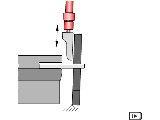[164] Exercise: Bending machine (directly-controlled pressure relief valve)
 A bending machine is used
to bend steel plates. The bending tools are driven by hydraulic
cylinders. It is now desired to use the bending machine for
considerably thicker steel plates than before. This requires a
hydraulic system pressure of 45 bar against the previous 30 bar.
According to the manufacturer's data, the pump used is suitable
for the higher operating pressure. Testing reveals, however, that
the bending process is now much too slow. In this case, leakage
losses in the piping or directional control valve are ruled out
as the cause of the problem. A directly-controlled pressure
relief valve (PRV) is installed as a safety valve. Measurements
of the volumetric flow (Q) as a function of pressure (p) are
available for this valve. A characteristic curve can than be used
to determine whether the loss of speed in the bending process is
due to the PRV.
A bending machine is used
to bend steel plates. The bending tools are driven by hydraulic
cylinders. It is now desired to use the bending machine for
considerably thicker steel plates than before. This requires a
hydraulic system pressure of 45 bar against the previous 30 bar.
According to the manufacturer's data, the pump used is suitable
for the higher operating pressure. Testing reveals, however, that
the bending process is now much too slow. In this case, leakage
losses in the piping or directional control valve are ruled out
as the cause of the problem. A directly-controlled pressure
relief valve (PRV) is installed as a safety valve. Measurements
of the volumetric flow (Q) as a function of pressure (p) are
available for this valve. A characteristic curve can than be used
to determine whether the loss of speed in the bending process is
due to the PRV.
The volumetric flow which is discharged to the tank when the PRV opens is entered on the horizontal axis. The characteristic curve shows that the opening point of the PRV is 44 bar, although it is set to 50 bar. This means that part of the pump delivery is diverted at pressures greater than 44 bar. Pressures of more than 44 bar are achieved during the bending process. Since, however, the flow is divided from 44 bar onwards, the volumetric flow to the cylinder is reduced from this point and the bending process slows down. Measure to be taken: The PRTV can be set to 60 bar if the overall installation has been designed for this higher pressure. Flow diversion will then take place from a pressure of 54 bar onwards.
An alternative solution would be to use a valve with a different response pressure.

